Problem Solving: Grades K-2
These problems are designed for students in Grades K-2:

Gr. K-2: Number Sense & Numerical Operations
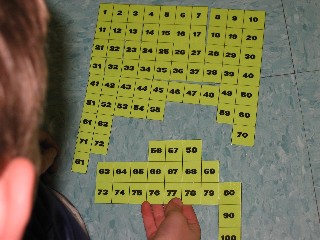
- Hundred Square Puzzles: Students at Port Monmouth Road School in Keansburg, NJ, use patterns to assemble hundred board puzzles. Teachers create puzzles that vary in both the number and size of pieces to differentiate this activity to best meet the varied needs of learners in the class.
 Animal Problems ask students to solve problems about pets and animals.
Animal Problems ask students to solve problems about pets and animals.
 Food Problems: students solve problems that relate to food, drawing to figure out how many cookies, pizza, cupcakes were eaten in all.
Food Problems: students solve problems that relate to food, drawing to figure out how many cookies, pizza, cupcakes were eaten in all.
 Winter Fun problems use snowmen to engage kindergarteners in problem solving.
Winter Fun problems use snowmen to engage kindergarteners in problem solving.
 Largest Sum challenges students to arrange given digits to produce the largest sum.
Largest Sum challenges students to arrange given digits to produce the largest sum.
 Smallest Sum challenges students to arrange given digits to produce the smallest sum.
Smallest Sum challenges students to arrange given digits to produce the smallest sum.
 Largest Differencechallenges students to arrange the given digits to produce the largest difference.
Largest Differencechallenges students to arrange the given digits to produce the largest difference.
 Smallest Difference challenges students to arrange the given digits to produce the smallest difference.
Smallest Difference challenges students to arrange the given digits to produce the smallest difference.
 Bean Bags assesses student understanding of place value using base-ten longs and cubes.
Bean Bags assesses student understanding of place value using base-ten longs and cubes.
-
 Digit Game - 1 challenges students to form the largest number possible using the three digits each player has drawn. Students must identify the winner of the game and explain how they decided who won.
Digit Game - 1 challenges students to form the largest number possible using the three digits each player has drawn. Students must identify the winner of the game and explain how they decided who won.
-
 Digit Game - 2 is similar to Digit Game -2 and can be used for additional practice.
Digit Game - 2 is similar to Digit Game -2 and can be used for additional practice.
-
 Ice Cream Treat addresses coin combinations and making change.
Ice Cream Treat addresses coin combinations and making change.
-
 Pizza Treat addresses coin combinations and making change.
Pizza Treat addresses coin combinations and making change.
Gr. K-2: Geometry & Measurement
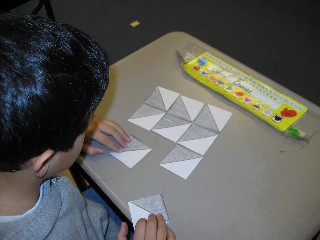
- Quilt Square Challenge: First graders at Flynn School in Perth Amboy, NJ, used quilt blocks and quilt mats to recreate 4x4 and 9x9 quilt block patterns. See Quilt Square Challenge on the Quilts webpage for more information on this activity and to download the blocks and mats for students.
 Shape Patterns: shape patterns that require students to draw what comes next. Teachers should ask students to explain how they know what comes next to develop students' ability to explain their thinking.
Shape Patterns: shape patterns that require students to draw what comes next. Teachers should ask students to explain how they know what comes next to develop students' ability to explain their thinking.
 Class Gardens measures student understanding of area and perimeter.
Class Gardens measures student understanding of area and perimeter.
Gr. K-2: Patterns & Algebra
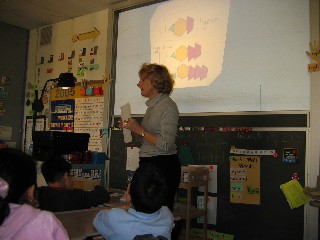
- Growing Patterns in Fish: First graders at Flynn School in Perth Amboy, NJ, looked for patterns in the growing fish from Marilyn Burns' Algebraic Thinking book. Students used pattern blocks to make the fish of each age, organized the data in a T-chart, then predicted what older fish would like based on the patterns they found.
-
 Bay Street requires students to analyze the pattern of house numbers on Bay Street. Students write down the pattern they see and use this number pattern to write in the missing house numbers.
Bay Street requires students to analyze the pattern of house numbers on Bay Street. Students write down the pattern they see and use this number pattern to write in the missing house numbers.
-
 King Street requires students to analyze the pattern of house numbers on King Street. Students write down the pattern they see and use this number pattern to write in the missing house numbers.
King Street requires students to analyze the pattern of house numbers on King Street. Students write down the pattern they see and use this number pattern to write in the missing house numbers.
 Pattern Problems: visual patterns that require students to draw what comes next. Teachers should ask students to explain how they know what comes next to develop students' ability to explain their thinking.
Pattern Problems: visual patterns that require students to draw what comes next. Teachers should ask students to explain how they know what comes next to develop students' ability to explain their thinking.
 Shape Patterns: shape patterns that require students to draw what comes next. Teachers should ask students to explain how they know what comes next to develop students' ability to explain their thinking.
Shape Patterns: shape patterns that require students to draw what comes next. Teachers should ask students to explain how they know what comes next to develop students' ability to explain their thinking.
 Winter Patterns use snowmen, sleds and mittens to explore patterns.
Winter Patterns use snowmen, sleds and mittens to explore patterns.
Gr. K-2: Data Analysis & Probability
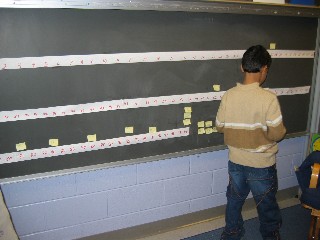
- Count in a Minute: First graders at Flynn School in Perth Amboy, NJ, used post-its to create a line plot of how high they could count in a minute. Students then analyzed the data to decide how high most first graders could count.
 Birthdays requires students to interpret data in a bar graph.
Birthdays requires students to interpret data in a bar graph.
 Fair Game assesses student understanding of probability through in spinner games.
Fair Game assesses student understanding of probability through in spinner games.
 Odd-Even Game requires students to interpret data in a tally chart.
Odd-Even Game requires students to interpret data in a tally chart.
 Favorite Pets requires students to analyze the information in a tally chart of students' favorite pets.
Favorite Pets requires students to analyze the information in a tally chart of students' favorite pets.
 Favorite Ice Cream requires students to analyze the information in a tally chart about chocolate and vanilla ice cream.
Favorite Ice Cream requires students to analyze the information in a tally chart about chocolate and vanilla ice cream.
 Pet Survey requires that students use data in a frequency table to construct a bar graph and answer questions about the graph.
Pet Survey requires that students use data in a frequency table to construct a bar graph and answer questions about the graph.
 Heads & Tails Data Collection requires students to decide if a two coin tossing game is fair or not if one player wins if the coins match (both heads or both tails) and the other player wins if the coins do not match (one heads and one tails).
Heads & Tails Data Collection requires students to decide if a two coin tossing game is fair or not if one player wins if the coins match (both heads or both tails) and the other player wins if the coins do not match (one heads and one tails).
Gr. K-2: Discrete Math
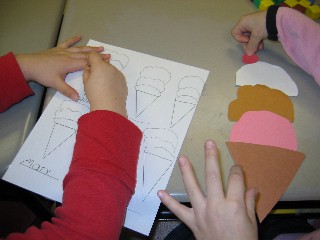
- Ice Cream Cones: First grade teachers at Flynn School in Perth Amboy, NJ, asked students to figure out how many different 3-scoop ice cream cones they could make make using chocolate, vanilla and strawberry ice creams. Student pairs used cutouts of cones and scoops to assemble then record the different combinations.
 Stoplights requires students to use an orderly counting method to discover how many different stoplights can be made using a combination of red, green and yellow blocks. Students may use linking cubes to model the stoplights and record combinations by coloring the sheet appropriately.
Stoplights requires students to use an orderly counting method to discover how many different stoplights can be made using a combination of red, green and yellow blocks. Students may use linking cubes to model the stoplights and record combinations by coloring the sheet appropriately.
